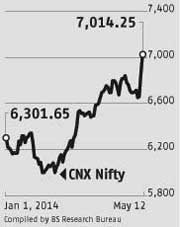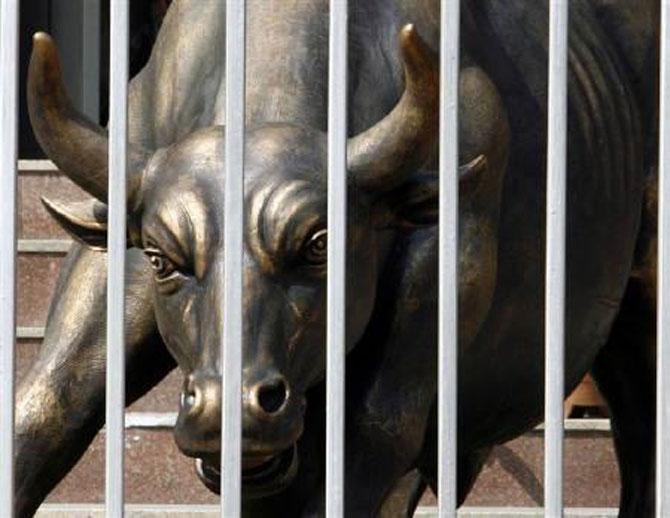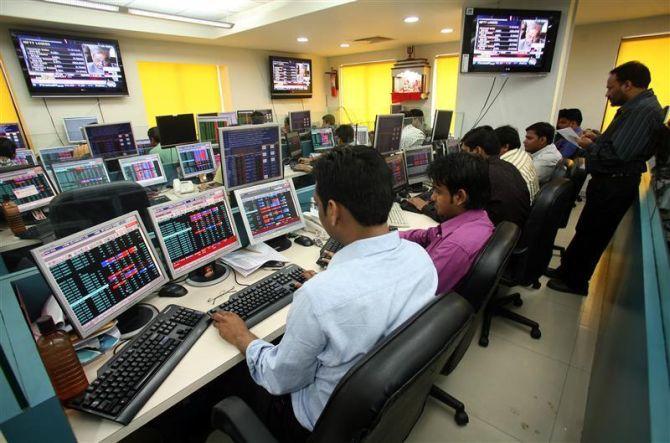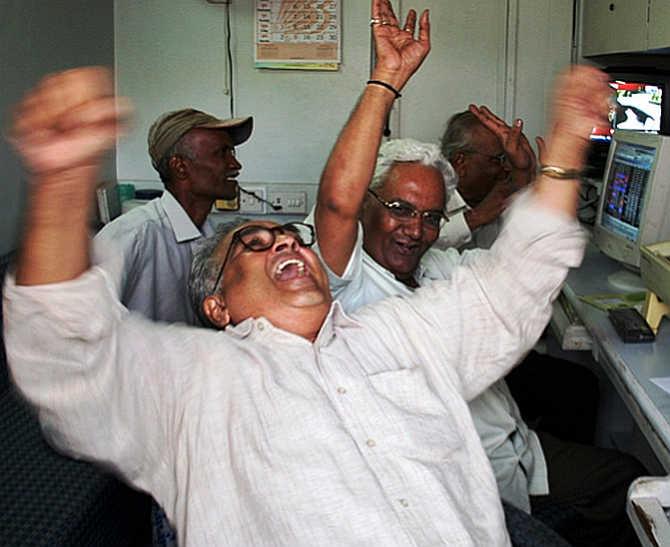 | « Back to article | Print this article |
Is this just a hope rally or India's defining moment?
India’s real GDP growth is expected to move higher to an average of 6.75 per cent over the next 10 years, rues Malini Bhupta.
May is not known to be a positive month for equities because that's when fund managers 'sell and go away'.
MSCI Asia-ex-Japan has corrected 5-10 per cent over May and June in three out of the past four years. But nobody’s going anywhere this May, at least not yet.
The benchmark indices have hit their life-time highs even before elections results unfold on May 16.
The markets did take a breather in April with the Sensex rising 0.1 per cent but the bulls are raging again.
Since nothing has changed fundamentally on the ground, the sceptics are saying, “sell the rally”.
Amidst such caution, foreign brokerages are coming out with a radically different view. Experts who had turned bearish on India way back in 2010-11, thanks to the country’s structural imbalances, are saying India’s defining moment is here.
Click NEXT to read further. . .
Is this just a hope rally or India's defining moment?
Since 2009, Chetan Ahya, chief Asia economist at Morgan Stanley, has maintained India’s overall policy mix, which was focused on redistribution rather than boosting growth, has caused a deterioration in productivity trends.
Ahya now believes India is emerging from this stagflationary type of environment.
Morgan Stanley’s report titled ‘India Next’ explains how India will get there.
In its base case, Morgan Stanley expects India’s real GDP growth to move higher to an average of 6.75 per cent over the next 10 years.
“If our projections were to come to fruition, India’s economy would pass the $5-trillion dollar mark, a feat that has been achieved by only the US and China thus far and would make India the fifth-largest economy (from 10th currently) in the world.”
Click NEXT to read further. . .
Is this just a hope rally or India's defining moment?
 Even as local pundits lack conviction, foreign investors are quietly churning their portfolio, after hiding behind defensives in the past few years. Abhay Laijawala, managing director and head of research at Deutsche Equities, was among the earliest to predict that India was at the cusp of a bull run in January this year.
Even as local pundits lack conviction, foreign investors are quietly churning their portfolio, after hiding behind defensives in the past few years. Abhay Laijawala, managing director and head of research at Deutsche Equities, was among the earliest to predict that India was at the cusp of a bull run in January this year.
Unlike its peers, Deutsche Equities is not betting on multiple scenarios.
Laijawala says: “Our view is that the election results are likely to throw up a decisive verdict.
"Any new government will have to address capital formation and revival of the industrial cycle will be the key priority. We believe India’s incremental capital output ratio has now touched seven and, in our view, it needs to return to the longer-term average of four.
Click NEXT to read further. . .
Is this just a hope rally or India's defining moment?
"Within six-eight months, we expect a perceptible improvement in the industrial cycle.
Also, the last couple of weeks has seen a visible shift in the portfolios of foreign institutional investors, who are now looking at industrials, banks and other domestic cyclicals after hiding behind defensives for long.
"Portfolio reallocation by FIIs is a sign of investor confidence in Indian equities.”
India looks rather attractive compared to other emerging markets, which continue to struggle with macro-economic headwinds.
India is expected to witness unprecedented foreign capital flows over the next few months.
Foreign funds are already churning their portfolios and beginning to go overweight on autos, cement, industrials, infrastructure and capital goods.
In time, they could go underweight on technology and consumer staples.
Click NEXT to read further. . .




